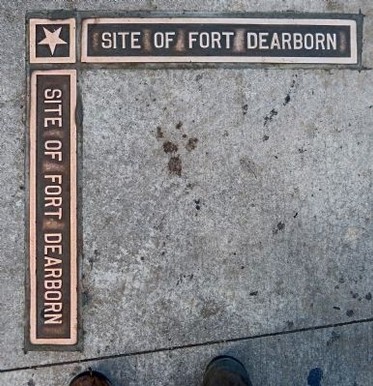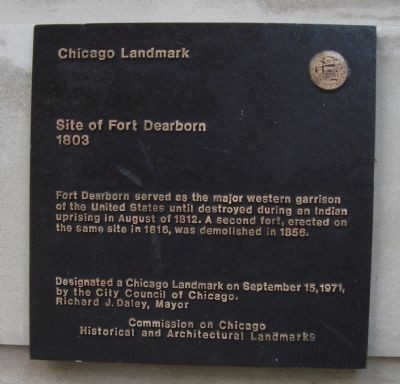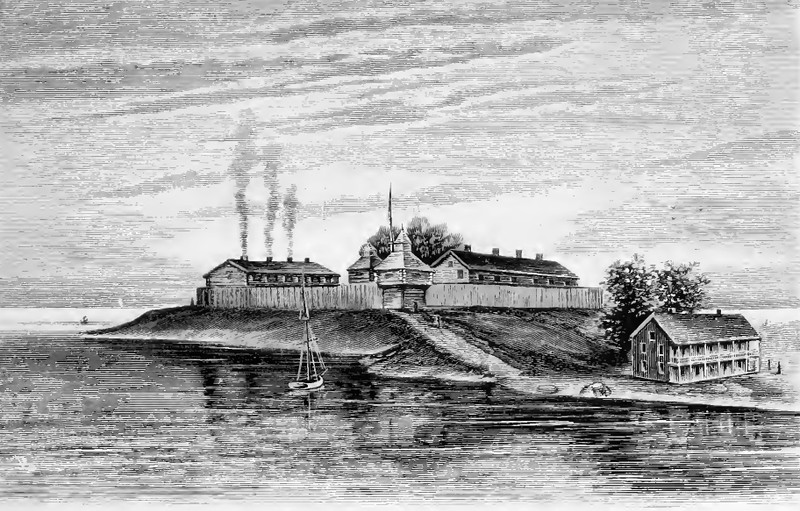Site of Fort Dearborn
Introduction
Text-to-speech Audio
Images
This sidewalk marker designated the location of Fort Dearborn.

Fort Dearborn Marker

Fort Dearborn aprox.1804

Backstory and Context
Text-to-speech Audio
With the Treaty of Greenville, 1795, the Potawatomies, Miamis, and their allies, relinquished their right to a parcel of land at the mouth of the Chicago River. This piece of navigable water way became even more important after the Louisiana Purchase, therefore, Captain John Whistler arrived in 1803 to build Fort Dearborn. The fort derives its name from President Thomas Jefferson’s secretary of war, Henry Dearborn. It consisted of two block houses, one at the southeast and the other at the southwest corner of the enclosure, which was surrounded by a stout palisade of timber. There was a subterranean passage to the river, which might have been used as a means of escape in an emergency, or to supply water to the garrison in case of a siege (Dearborn).
As the War of 1812 was underway, what has become known as the Fort Dearborn Massacre happened on August 15,1812. After the fall of Fort Mackinac on July 17, 1812, Fort Dearborn was cut of from supplies and reinforcements. Orders from General William Hull, the commander of all U.S. troops in the Old Northwest, ordered Captain Nathan Heald to evacuate the fort Fort (Chicago Mag). Captain Heald was to lead the men and women to Fort Wayne in Indiana. With 55 soldiers, 12 Militia, 9 women, and 18 children on the march to Fort Wayne, they soon encountered a hostile force of around 500 Potawatomi indians. The Indians would kill more than 60 men, women, and children in the Massacre and burn the fort down the next day.
A second Fort Dearborn was built four years later on the very same site. The U.S. Army returned to rebuild the Fort after a treaty in 1816, in which the Potawatomies ceded to the United States all the country around the region. The new fort was the center for military activity during the Black Hawk War in 1832, and served as a refuge for the area residents. By the 1840 the U.S. Army had no more use for it, and was now in the possession of the city of Chicago. Fort Dearborn was demolished in 1857. Fort Dearborn is commemorated as one of the four red stars on the Chicago Flag. The fort established Chicago’s core and its early pattern of growth. More than 200 years after it was built, Chicago is still centered on the few acres just south of where Fort Dearborn once stood(Architecture).
Sources
Chicago Architecture. . . http://www.architecture.org/learn/resources/architecture-dictionary/entry/fort-dearborn/. Architecture
Chicago Mag. True Story of The Deadly Encounter At Fort Dearborn.. . . http://www.chicagomag.com/Chicago-Magazine/December-2009/The-True-Story-of-the-Deadly-Encounter-at-Fort-Dearborn/index.php?cp=2&si=10#galleryanc. Chicago Mag
Fort Dearborn. . . http://www.encyclopedia.chicagohistory.org/pages/477.html. Ft. Dearborn
